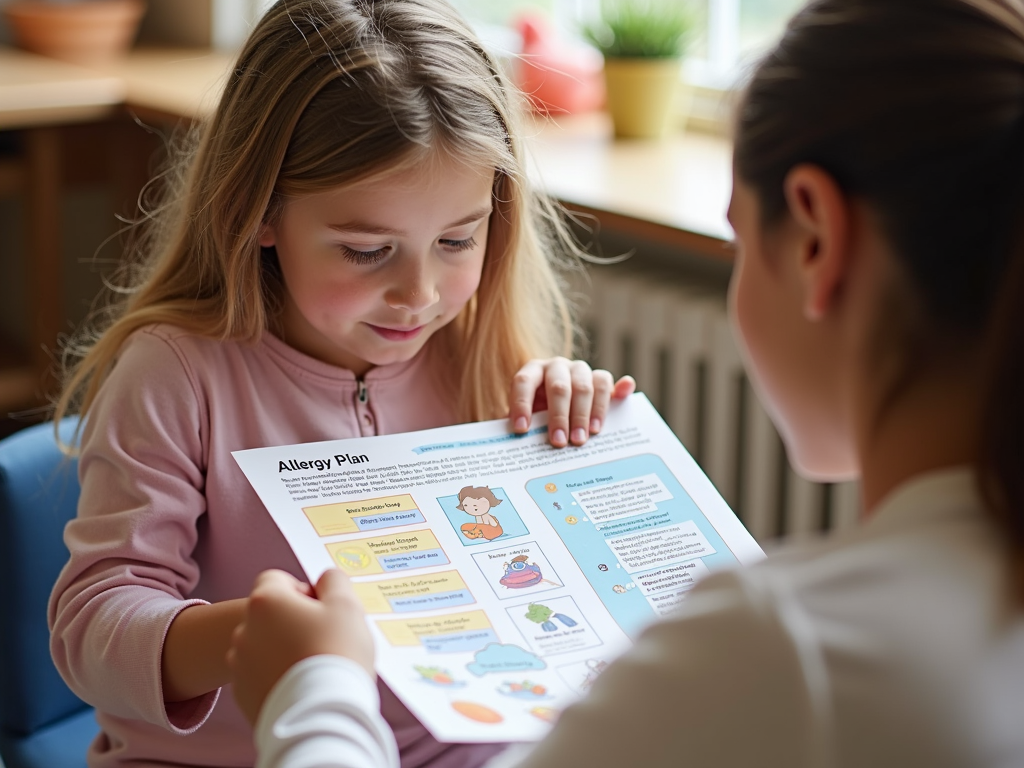Overview
Allergies can turn a normal school day into a crisis. This guide equips teachers with practical tools and knowledge to manage allergy emergencies, focusing on understanding FPIES and allergen exposure. Let’s keep students safe together.

Understanding Allergies in School Settings
Allergies happen when the immune system overreacts to something harmless, like food or pollen. In schools, this is a big deal because kids are exposed to all sorts of triggers—think snacks, crafts, or even the playground. Teachers need to know what’s at stake and how to act fast.
Why does this matter? One in 13 kids has a food allergy, according to Food Allergy Research & Education (FARE). That’s a lot of students who could need help at any moment.
Common Allergens in Schools
Here’s a quick look at what might set off an allergy in your classroom:
| Allergen | Potential Sources in Schools |
|---|---|
| Peanuts | Snacks, lunches, art supplies |
| Tree nuts | Snacks, lunches |
| Milk | Lunches, snacks, cooking activities |
| Eggs | Lunches, snacks, baking projects |
| Wheat | Lunches, snacks, art supplies |
| Soy | Lunches, snacks, processed foods |
| Fish | Lunches, science projects |
| Shellfish | Lunches, science projects |
| Insect stings | Outdoor play, field trips |
| Latex | Balloons, gloves, gym equipment |
Spotting these risks is the first step to keeping kids safe.

Focus on FPIES
What Is FPIES?
Food Protein-Induced Enterocolitis Syndrome, or FPIES, isn’t your typical allergy. It’s a rare condition that hits the stomach and intestines, often in young kids. Unlike peanut allergies that cause instant hives, FPIES reactions are delayed—sometimes by hours. Triggers like milk, soy, rice, or oats can spark trouble.
This delay makes FPIES tricky. A child might eat lunch and seem fine, only to get sick later. Teachers need to understand this to catch it early. Check out more details from the American Academy of Allergy, Asthma & Immunology (AAAAI).
Symptoms of FPIES
When acute FPIES strikes, it’s serious. Watch for these signs:
- Repeated vomiting (often forceful)
- Diarrhea
- Extreme tiredness
- Pale skin
- Dehydration
These can escalate fast, so don’t wait to act. Unlike other allergies, there’s no rash or wheezing—just gut trouble that needs quick attention.
Managing FPIES in Schools
Handling FPIES takes teamwork. Start by talking to parents about the child’s triggers—every kid is different. Next, make a clear plan: no trigger foods in lunches or snacks. If a reaction happens, skip the EpiPen—it won’t help. Instead, call for medical help right away and focus on keeping the child calm and hydrated until pros arrive.
Training is key. Make sure everyone knows the drill, from substitutes to lunch staff.

Creating an Allergy-Friendly Classroom
A safe classroom doesn’t happen by accident—it takes effort. Here’s how to build one:
- Talk to Parents: At the start of the year, ask about allergies. Get specifics—triggers, symptoms, what to do.
- Make a Plan: Write an allergy action plan for each kid. Include their picture, triggers, and emergency steps.
- Teach Everyone: Show staff how to spot trouble. Tell kids why sharing snacks can hurt.
- Set Rules: Try nut-free zones or handwashing after lunch. Small changes make a big difference.
- Stock Supplies: Keep EpiPens handy and train people to use them.
The CDC’s guidelines on food allergies offer solid tips to get started.
Responding to Allergy Emergencies
When an allergy hits, every second counts. Follow these steps:
- Spot the Signs: Look for hives, swelling, breathing trouble, or vomiting (especially with FPIES).
- Use the Plan: Grab the student’s allergy action plan and follow it.
- Give Medicine: If trained, use an EpiPen for anaphylaxis. For FPIES, focus on getting help fast.
- Call for Backup: Dial emergency services if it’s serious—don’t hesitate.
- Tell Parents: Let them know what’s happening right away.
- Write It Down: Note what happened for later.
Quick action can change everything. Practice this so it’s second nature.

Personal Insights and Experiences
Teachers often learn on the job when it comes to allergies. One shared how a student with FPIES got sick after a rice snack at a party. The teacher didn’t panic—she followed the plan, called for help, and kept the class steady. The child was okay, thanks to that prep.
Another teacher said talking to parents early made all the difference. They set up a system: labeled lunchboxes, a backup snack stash, and a buddy to watch out. It’s about building trust and staying ready.
Summary
Handling allergy emergencies as a teacher means knowing your stuff—especially about FPIES—and being ready to act. From spotting allergens to making a safe space, it’s all about protecting kids. With the right steps, you can handle anything that comes your way.
Discuss Here